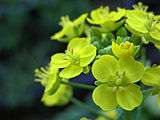Bok choy
| Bok choy | |
|---|---|
|
Brassica rapa chinensis, called "bok choy" in the United States | |
| Species | Brassica rapa |
| Cultivar group | Chinensis |
| Origin | China, before the 15th century |
Bok choy or pak choi (Chinese: 青菜; Brassica rapa subsp. chinensis) is a type of Chinese cabbage. Chinensis varieties do not form heads and have smooth, dark green leaf blades instead, forming a cluster reminiscent of mustard greens or celery. Chinensis varieties are popular in southern China and Southeast Asia. Being winter-hardy, they are increasingly grown in Northern Europe. This group was originally classified as its own species under the name Brassica chinensis by Linnaeus.
Spelling and naming variations
| Green bok choy | |
.jpg) | |
| Chinese name | |
|---|---|
| Chinese | 青菜 |
| Hanyu Pinyin | qīng cài |
| IPA | [tɕʰíŋ.tsʰâi̯] |
| Romanization | tsching tsae |
| Cantonese and Southern Min name | |
| Chinese | 白菜 |
| Jyutping | baak6 coi3 |
| IPA | [pàːk tsʰɔ̄ːy] |
| Hokkien POJ | be̍h-chhài or pe̍h-chhài |
| Korean name | |
| Hangul | 청경채 |
| Hanja | 靑莖菜 |
| Revised Romanization | cheonggyeongchae |
| Japanese name | |
| Kanji | 青梗菜 |
| Romanization | chingensai |
Other than the ambiguous term "Chinese cabbage", the most widely used name in North America for the chinensis variety is bok choy (from the Cantonese, literally meaning "white vegetable"; also spelled pak choi, bok choi, and pak choy). In the UK, Australia, South Africa, and other Commonwealth Nations, the term pak choi is used. Less commonly, the descriptive English names Chinese chard, Chinese mustard, celery mustard, and spoon cabbage are also employed.
In Australia, the New South Wales Department of Primary Industries has redefined many transcribed names to refer to specific cultivars. In addition, they have introduced the word buk choy to refer to a specific kind of cabbage distinct from pak choy.[1][2]
In China, the majority of Chinese speak Mandarin (about 955 million people), and for them, the term used most commonly is 青菜 qīng cài (literally "blue-green vegetable"). Although the term 白菜 is pronounced "baak choi" in Cantonese, the same characters are pronounced "bái cài" by Mandarin speakers and used as the name for Napa cabbage which they call "Chinese cabbage" when speaking English.
In the Philippines, it is called "pechay" or "petsay".
Nutritional value
| Nutritional value per 100 g (3.5 oz) | |
|---|---|
| Energy | 54 kJ (13 kcal) |
|
2.2 g | |
| Dietary fiber | 1.0 g |
|
0.2 g | |
|
1.5 g | |
| Vitamins | |
| Vitamin A equiv. |
(30%) 243 μg (25%) 2681 μg |
| Thiamine (B1) |
(3%) 0.04 mg |
| Riboflavin (B2) |
(6%) 0.07 mg |
| Niacin (B3) |
(3%) 0.5 mg |
| Pantothenic acid (B5) |
(2%) 0.09 mg |
| Vitamin B6 |
(15%) 0.19 mg |
| Folate (B9) |
(17%) 66 μg |
| Vitamin C |
(54%) 45 mg |
| Vitamin K |
(44%) 46 μg |
| Minerals | |
| Calcium |
(11%) 105 mg |
| Iron |
(6%) 0.80 mg |
| Magnesium |
(5%) 19 mg |
| Manganese |
(8%) 0.16 mg |
| Potassium |
(5%) 252 mg |
| Sodium |
(4%) 65 mg |
| Other constituents | |
| Water | 95.3 g |
|
| |
| |
| Percentages are roughly approximated using US recommendations for adults. | |
Raw Chinese cabbage is 95% water, 2% carbohydrates, 1% protein and less than 1% fat (table). In a 100 gram amount, raw Chinese cabbage supplies 13 calories and is a rich source (20% or more of the Daily Value, DV) of vitamin A (30% DV), vitamin C (54% DV) and vitamin K (44% DV), while providing folate, vitamin B6 and calcium in moderate amounts (10-17% DV) (table).
Chinese cabbage was ranked #2 for nutrient density out of 41 nutrient-rich plant foods.[3]
Toxic effects
Bok choy contains glucosinolates. These compounds have been reported to prevent cancer in small doses, but, like many substances, can be toxic to humans in large doses, particularly to people who are already seriously ill. In 2009, an elderly diabetic woman who had been consuming 1 to 1.5 kg of raw bok choy per day in an attempt to treat her diabetes, developed hypothyroidism for reasons relating to her diabetes, resulting in myxedema coma.[4]
Gallery
-
Baby bok choy
-

B. rapa chinesis
-

B. rapa chinesis has yellow flowers
-

Cooked bok choy
See also
References
| Wikimedia Commons has media related to Brassica rapa subsp. chinensis. |
| Wikibooks Cookbook has a recipe/module on |
- ↑ "Help is on the way for consumers confused by the wide array of Asian vegetables on sale". 2009-10-22. Archived from the original on 2007-08-20. Retrieved 2011-09-08.
- ↑ "Asian vegetable names" (PDF). Archived from the original (PDF) on 2006-10-30. Retrieved 2011-09-08.
- ↑ di Noia, Jennifer (2014-06-05). "Defining Powerhouse Fruits and Vegetables: A Nutrient Density Approach". Preventing Chronic Disease. National Center for Chronic Disease Prevention and Health Promotion (USA). 11. doi:10.5888/pcd11.130390. ISSN 1545-1151. Retrieved 2014-06-11.
- ↑ Rabin, Roni Caryn (2010-05-24). "Regimens: Eat Your Vegetables, but Not Too Many". The New York Times. Retrieved 2010-06-03.